Birding in your backyard and beyond
Idaho’s beautiful landscapes are the backdrop to dozens of outdoor adventures. Public lands enthusiasts can grab their bikes or skis and head up the mountain, while water lovers can find thrill soaring down some of Idaho’s iconic rivers. Although it may seem like there’s an outdoor activity for every Idahoan to enjoy in the Gem State, these hobbies aren’t always inclusive. Whether it’s because of physical ability, lack of access, or lack of gear – not everyone has the chance to bag an Idaho peak or float a river. But one Idaho activity can be an easy, inclusive, low-cost way to connect with nature: birding.Birding can be as easy as looking out your kitchen window or as demanding as camping out in the desert, and rising before dawn to watch the sage grouse’s early-spring mating dance. The hobby requires little gear and is accessible for many abilities, and there’s plenty to see for birders in Idaho. The Gem State is home to more than 430 species of birds, giving anyone who tilts their eyes to the skies something to look for.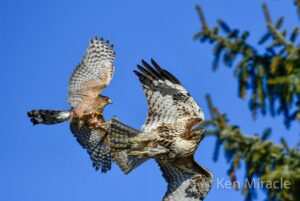
A growing hobby
Birdwatching hit a boom at the start of the Covid-19 pandemic and has continued to grow since – and for good reason. Birding is great for anyone who is curious about nature and wants to learn more about the world around them. Watching, hearing, and learning about birds can also be a gateway into building a deeper appreciation for where you live. Here are some great reasons to start your birding adventure now! 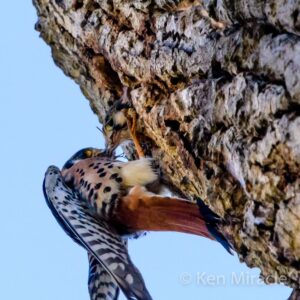
- Birding can be low-cost. If you plan on hiking while birdwatching, you’ll really only need a good pair of shoes. If you want to dive deeper into the hobby, the initial investment on a pair of binoculars and a guidebook can pay off. There are also free online guides and smartphone apps to help you identify birds.
- Birding is what you make it! It’s a hobby you can do from anywhere birds are in earshot or view – in your backyard, on vacation, while you walk the dog. You can even do it from inside your home by watching feeders or listening out your window.
- Make it social. Birding is a great way to bring people together. It can be a fun family activity or you can join local birding groups and programs. But if you’d rather do it alone, you can!
How’s your bird brain? Get to know your neighbors
Some birds in your neighborhood are common, year-round residents just like you! Learning to identify them and their habits is a great way to start birding. For the beginner birder in Idaho, here are some common birds you may see in your backyard or neighborhood.American Robin: This plump bird is one of the most familiar birds in Idaho and is native to the state year round. This thrush is known for its rusty red breast, dark head and dark back. You can also look for a white throat and white splotches around the eyes. Robins are comfortable around people and common in backyards. They mainly eat worms and insects so you may see one pulling up an earthworm from your garden! House Finch: It is common to see House Finches around buildings, backyards, parks and other areas with people. This social bird has a reddish hue, a notched tail, and a conical beak to eat seeds. Males have rosy red on their heads and chests, with brown streaked sides. Females are more brown and have streaks from their throat down their body. If you put out a new feeder in your backyard, this curious bird may be the first to visit, and they may also grace you with a bubbly song.
House Finch: It is common to see House Finches around buildings, backyards, parks and other areas with people. This social bird has a reddish hue, a notched tail, and a conical beak to eat seeds. Males have rosy red on their heads and chests, with brown streaked sides. Females are more brown and have streaks from their throat down their body. If you put out a new feeder in your backyard, this curious bird may be the first to visit, and they may also grace you with a bubbly song.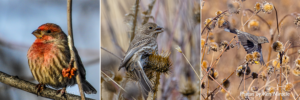 American Goldfinch: These small, colorful birds are very common in Idaho. Males are a vivid yellow with a black cap and black wings, while females are a duller yellow and don’t sport the black cap. In winter, both males and females are a paler yellow, sometimes light brown. These birds appreciate your feeders and will visit them often – maybe even upside down!
American Goldfinch: These small, colorful birds are very common in Idaho. Males are a vivid yellow with a black cap and black wings, while females are a duller yellow and don’t sport the black cap. In winter, both males and females are a paler yellow, sometimes light brown. These birds appreciate your feeders and will visit them often – maybe even upside down!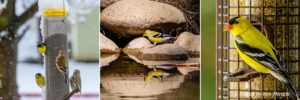 Mourning Dove: You’ve probably seen these birds perched high up in trees, on a telephone wire near your home, or feeding on the ground. The mostly grayish dove has large black spots on its wings and a long thin tail. They also have a black bill and distinctive blue eye-ring.
Mourning Dove: You’ve probably seen these birds perched high up in trees, on a telephone wire near your home, or feeding on the ground. The mostly grayish dove has large black spots on its wings and a long thin tail. They also have a black bill and distinctive blue eye-ring.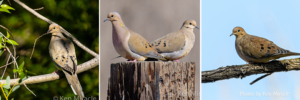 Black-capped Chickadee: This cutie is a fan favorite, and it’s easy to see why! These tiny birds have a large head that features a black cap and bib. That big head of theirs also makes a lot of sound! These birds are extremely vocal, and well-known for a simple song of a few whistles that sounds like “hey sweetie.” They also make a distinctive “chickadee-dee-dee” call, living up to their name.
Black-capped Chickadee: This cutie is a fan favorite, and it’s easy to see why! These tiny birds have a large head that features a black cap and bib. That big head of theirs also makes a lot of sound! These birds are extremely vocal, and well-known for a simple song of a few whistles that sounds like “hey sweetie.” They also make a distinctive “chickadee-dee-dee” call, living up to their name.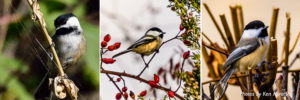 Downy Woodpecker: These relatively small woodpeckers have a short bill, white bellies, and a mostly black back that has spots of white. Males have a red spot on the back of their head. Oftentimes people confuse these with the Hairy Woodpecker, which has a longer bill and is a bit larger than the Downy.
Downy Woodpecker: These relatively small woodpeckers have a short bill, white bellies, and a mostly black back that has spots of white. Males have a red spot on the back of their head. Oftentimes people confuse these with the Hairy Woodpecker, which has a longer bill and is a bit larger than the Downy.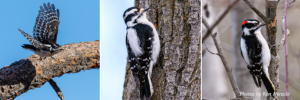 Northern Flicker: This large woodpecker is commonly spotted year-round in Idaho. Flickers are a blend of tan with black on its back, black spots on its belly and a large black throat patch. The male also has a red marking on its face, right below its eyes. In flight, it’s easy to spot the flicker’s white rump patch and reddish underwings. This bird likes to stay near trees, so you may have to venture down a trail to see one if you don’t have a lot of trees in your neighborhood.
Northern Flicker: This large woodpecker is commonly spotted year-round in Idaho. Flickers are a blend of tan with black on its back, black spots on its belly and a large black throat patch. The male also has a red marking on its face, right below its eyes. In flight, it’s easy to spot the flicker’s white rump patch and reddish underwings. This bird likes to stay near trees, so you may have to venture down a trail to see one if you don’t have a lot of trees in your neighborhood.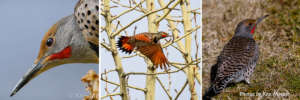 Song Sparrow: These sparrows primarily nest in weeds and grasses, so you may spot one on the ground. The bird’s back and body is mostly rust-brown with gray streaks throughout. Its white chest also has brown streaks leading to its center. The bird wears a brown crown on its head and has a gray stripe across its face. If you’re lucky enough to have one visit your yard – keep quiet and let the Song Sparrow serenade you with its song, which consists of three short notes followed by a trill.
Song Sparrow: These sparrows primarily nest in weeds and grasses, so you may spot one on the ground. The bird’s back and body is mostly rust-brown with gray streaks throughout. Its white chest also has brown streaks leading to its center. The bird wears a brown crown on its head and has a gray stripe across its face. If you’re lucky enough to have one visit your yard – keep quiet and let the Song Sparrow serenade you with its song, which consists of three short notes followed by a trill. Dark-eyed Junco: Also known as the Snowbird, the Dark-eyed Junco is commonly seen in the winter when it moves to lower elevations. This small-sized bird has a pink bill, white outer tail feathers, and pinkish-brown sides. The males have a dark head and females have a light brownish-gray head and are lighter colored overall. You may spot one on your feeder during winter months!
Dark-eyed Junco: Also known as the Snowbird, the Dark-eyed Junco is commonly seen in the winter when it moves to lower elevations. This small-sized bird has a pink bill, white outer tail feathers, and pinkish-brown sides. The males have a dark head and females have a light brownish-gray head and are lighter colored overall. You may spot one on your feeder during winter months!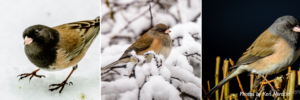 European Starling: This bird is always runway ready with its shiny, black plumage. Breeding adults are darker black with a green-purple tint. In winter, starlings lose their glossiness and don a new style – white spots on their body. This bird isn’t native to Idaho or even the United States. It was brought over from Europe in the 1890s and released in New York City’s Central Park. This invasive species has conquered a lot of ground since, due to its ability to adapt to human development and broaden its diet.
European Starling: This bird is always runway ready with its shiny, black plumage. Breeding adults are darker black with a green-purple tint. In winter, starlings lose their glossiness and don a new style – white spots on their body. This bird isn’t native to Idaho or even the United States. It was brought over from Europe in the 1890s and released in New York City’s Central Park. This invasive species has conquered a lot of ground since, due to its ability to adapt to human development and broaden its diet. 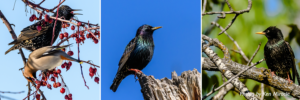 Red breasted Nuthatch: This small songbird has a brownish-red breast, with a blue and gray back and wings. Their head is white with a black stripe over their eye and a black crown on top of their head. If one visits you, you can hope to hear its melodious call.
Red breasted Nuthatch: This small songbird has a brownish-red breast, with a blue and gray back and wings. Their head is white with a black stripe over their eye and a black crown on top of their head. If one visits you, you can hope to hear its melodious call.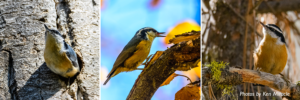 Bullock’s Oriole: This songbird is known for its brilliant colors and brilliant movement. Adult males are flame-orange with a white patch on their wing and a neat line through the eye. Females are a duller orange with gray. Bullock’s Orioles are quite acrobatic and often spotted hanging upside down from branches while foraging and weaving their hanging, basket-like nests in trees. You may spot them in open woodlands or in tall trees along the Greenbelt. If you want to attract one to your yard, offer up some nectar or orange halves in the summer – these birds love a sweet treat and will sometimes raid hummingbird feeders of their sugar water!
Bullock’s Oriole: This songbird is known for its brilliant colors and brilliant movement. Adult males are flame-orange with a white patch on their wing and a neat line through the eye. Females are a duller orange with gray. Bullock’s Orioles are quite acrobatic and often spotted hanging upside down from branches while foraging and weaving their hanging, basket-like nests in trees. You may spot them in open woodlands or in tall trees along the Greenbelt. If you want to attract one to your yard, offer up some nectar or orange halves in the summer – these birds love a sweet treat and will sometimes raid hummingbird feeders of their sugar water! Cedar waxwing: This sharp-looking bird has brown plumage with silky gray, lemon-colored markings. A black mask covers their face, a crest sits upon its head, and a bright red spot dots the middle of their silky wings. Although these birds live mainly in woodlands and on forest edges, you may see them in your neighborhood if berries are available – they can become intoxicated from consumption of over-ripe berries!
Cedar waxwing: This sharp-looking bird has brown plumage with silky gray, lemon-colored markings. A black mask covers their face, a crest sits upon its head, and a bright red spot dots the middle of their silky wings. Although these birds live mainly in woodlands and on forest edges, you may see them in your neighborhood if berries are available – they can become intoxicated from consumption of over-ripe berries!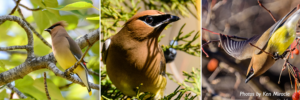 These are just a handful of the birds you may see in your backyard. The Cornell Lab of Ornithology has more information on bird species and their behavior, habitat, and more. For a guide to Boise’s birds, click here.
These are just a handful of the birds you may see in your backyard. The Cornell Lab of Ornithology has more information on bird species and their behavior, habitat, and more. For a guide to Boise’s birds, click here.
Bird responsibly!
As with any outdoor recreational activity, it’s important to recreate responsibly while birding. That means taking care of yourself and your environment. For yourself – bring water and snacks, make sure you are properly dressed, and be aware of your surroundings. As for the environment – avoid walking on any vegetation, making new paths, or breaking branches from plants and trees around you. Also be sure to avoid approaching or disturbing nesting birds, their eggs, or their nests. For the American Birding Associations full list of Birding Ethics, click here. And as always when you step into Idaho's outdoors, follow the Leave No Trace Seven Principles.
Giving back: Don't miss the 2024 Christmas Bird Count!
Winter is a great time to start your birdwatching journey. The annual Christmas Bird Count, which happens to be the longest-running community science program in the world, kicks off soon! This year’s count starts on December 14, 2024 and runs through January 5, 2025. For these three weeks, people across North America join together to take a snapshot of bird populations and submit their observations online—helping researchers and scientists gain a better understanding of how birds are doing and how we can help them. If you live in southwest Idaho, consider joining Golden Eagle Audubon Society for their Boise Christmas Bird Count! Or, learn more about the count on their website.Want to stay in the loop on Idaho’s birds and other wildlife? Sign up here for regular updates on ICL’s wildlife work.

